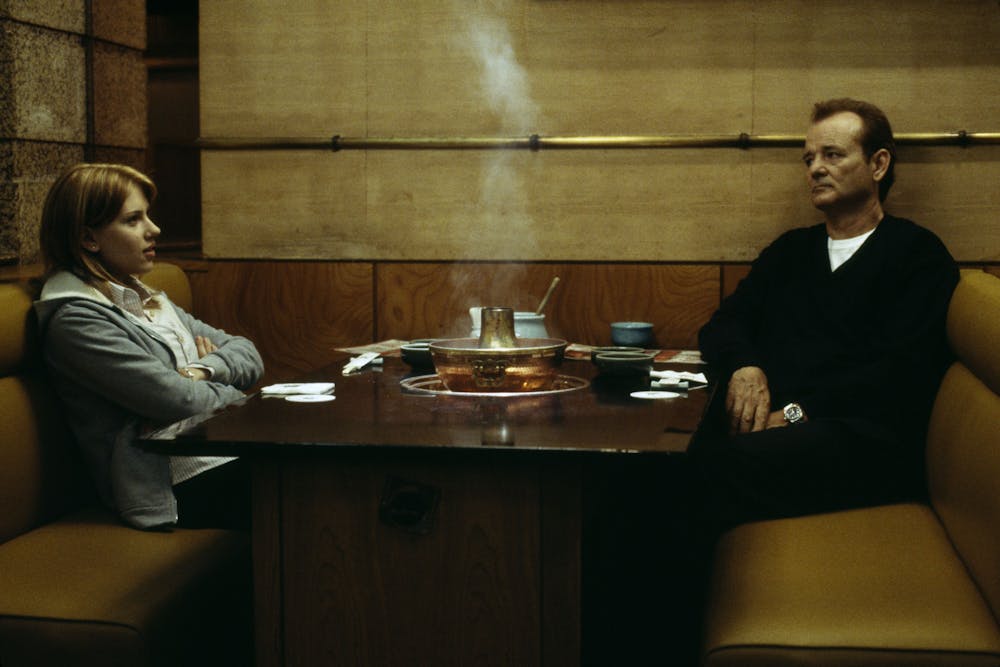“Let’s never come here again because it would never be as much fun.”
While the above line – attributed to protagonist Charlotte of the 2003 film "Lost in Translation" – might be true of the Park Hyatt in Tokyo, it isn’t true of Sofia Coppola’s magnum opus and its 20th birthday earlier this month. In “Lost in Translation,” an eighteen-year-old Scarlett Johansson and mid-to-late career Bill Murray have a semi-platonic one-week fling in Japan that's influenced as much by the director’s relationship to her father as her crumbling marriage.
Coppola wrote and directed "Lost in Translation" in the midst of the end of her four-year marriage to fellow director Spike Jonze (most famous for his directorial commentary on their relationship in the form of 2013’s “Her”). Johansson plays Charlotte, an artistically-inclined intellectual (an obvious stand-in for Coppola herself), while Murray’s Bob is a personable, washed-up actor who admits that he is “getting paid two million dollars to endorse a whiskey when [he] could be doing a play somewhere” (a slightly abstracted depiction of Coppola’s father, Francis Ford Coppola).
"Lost in Translation” has become defined by two moments: Johansson’s pink wig-covered head resting on Bill Murray’s hesitant shoulder, and a saccharin-sweet inaudible final goodbye. While the latter’s sincerity is undercut by speculation that misses the point of the moment, the appreciation of the former is felt as it was intended.
These moments’ magic is in their refutation of audience expectations. With all of the makings of a Hallmark card-worthy love story from the mind of Nora Ephron (writer of every 90’s rom-com you’ve ever heard of), "Lost in Translation" subverts comforting film tropes while helping Sofia Coppola understand herself beyond the confines of her marriage and the shadow of her father.
If we take Charlotte as an (almost) one-to-one stand-in for Coppola, we see a woman defined by her relationship to men. She is only in Japan for her husband’s photography career, spends much of her mental energy on an actress who takes up her husband’s time and only manages to verbalize her subconscious emotions with the help of a paternally-coded friend.
With 20 years of post-"Lost in Translation" hindsight, it’s clear that Coppola is one of the most recognizable and accomplished filmmakers in American cinema. However, "Lost in Translation" was only her second feature-length film. At the time of release, dialogue surrounding her was more about nepotism than talent. Coppola seemingly concluded that the only way to engage with the external dialogue – which had almost certainly become internalized – was to reframe it herself.
Referring back to the two most iconic scenes, each is defined by one thing: dialogue (or the lack thereof). Coppola, through Charlotte, can’t address her problems directly with her husband or her future. However, this silence doesn’t equate to insipidity. The emotions that wash over the viewer are inexpressible snippets of lives that will go well beyond these moments in time but never far in spirit. Silence has been co-opted from a manifestation of sadness and discomfort to an expression of purity and comfort. Yet this redefinition is only for Charlotte. Coppola, personally and professionally, will continue to be defined by her marriage to Spike Jonze. Any silence left between her and her ex-husband is still just that.
How did Coppola actualize herself? Who or what was she in conversation with in "Lost in Translation" to finally be able to “speak?” Bob is a comfort. For Charlotte, he represents both the past and future; he has felt any pains that could be borne in the future of her marriage, and his position and candor allow her to become childlike in her deference to his struggle-induced wisdom.
Charlotte’s respect for Bob’s life experiences parallels Sofia’s relationship with her father, Francis Ford Coppola, a man with a presence as large as his oeuvre. After a lengthy, self-indulgent career, he has become her biggest proponent, while also being the catalyst for her work’s fascination with unrealized father figures. His personality and status as one of the most accomplished directors in history leaves Sofia forever in his shadow. In an almost original sin-esque argument, "Lost in Translation" provides the text for Sofia’s reckoning with both the positive and negative effects her father has had on her personal life and career. Through him she is both punished and saved.
In a projected conversation between herself and her dad (through Charlotte and Bob), we see a young woman and an aged man who are equally lost, but unequally comfortable in their rudderlessness:
Charlotte: “I just don't know what I'm supposed to be.”
Bob: “You'll figure that out. The more you know who you are and what you want, the less you let things upset you.”
In this scene, Sofia uses the character inspired by her father to represent the part of herself that finally understands both their relationship and its impact on her marriage to Jonze.
While Charlotte’s on-screen life lasts a week, we’ve seen the lessons she learned manifest in the career of a storied filmmaker. "Lost in Translation" is a uniquely 2003 film – angered phone calls (rather than texts) about rugs and the color palette and texture of early-aughts clothing frame the story. However, the themes and emotion resonate just as passionately today. It is a uniquely universal yet ultimately personal film that offers both the audience and Sofia Coppola a glimpse into the director’s mind and heart.
Get The Chronicle straight to your inbox
Signup for our weekly newsletter. Cancel at any time.

